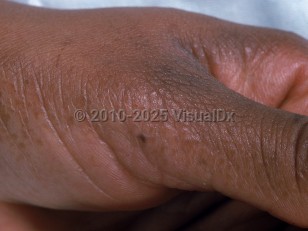Acrokeratoelastoidosis in Adult
Alerts and Notices
Important News & Links
Synopsis

Acrokeratoelastoidosis (AKE), also known as punctate palmoplantar keratoderma type 3, is an uncommon genodermatosis characterized by hyperkeratotic papules coalescing into plaques on the hands and feet. The lesions are asymptomatic and benign. The condition is quite rare, with only a handful of cases reported. It is inherited in an autosomal dominant pattern.
Abnormal and decreased elastic fibers in the dermis cause the characteristic lesions. Among the few scattered cases reported in the literature, there was no racial or sex predilection. Age of onset varies widely. Progression of disease has been reported during pregnancy. An association with both localized and systemic scleroderma has been suggested. The current understanding of pathogenesis includes a possible linkage to chromosome 2. An overproduction of filaggrin is thought to accumulate above the granular layer and is incorporated into the protein matrix of epidermal keratin. Nail changes are not usually described with AKE, but there has been at least one report of dystrophic nails in a patient with AKE.
Abnormal and decreased elastic fibers in the dermis cause the characteristic lesions. Among the few scattered cases reported in the literature, there was no racial or sex predilection. Age of onset varies widely. Progression of disease has been reported during pregnancy. An association with both localized and systemic scleroderma has been suggested. The current understanding of pathogenesis includes a possible linkage to chromosome 2. An overproduction of filaggrin is thought to accumulate above the granular layer and is incorporated into the protein matrix of epidermal keratin. Nail changes are not usually described with AKE, but there has been at least one report of dystrophic nails in a patient with AKE.
Codes
ICD10CM:
Q82.8 – Other specified congenital malformations of skin
SNOMEDCT:
111029001 – Acrokerato-elastoidosis
Q82.8 – Other specified congenital malformations of skin
SNOMEDCT:
111029001 – Acrokerato-elastoidosis
Look For
Subscription Required
Diagnostic Pearls
Subscription Required
Differential Diagnosis & Pitfalls

To perform a comparison, select diagnoses from the classic differential
Subscription Required
Best Tests
Subscription Required
Management Pearls
Subscription Required
Therapy
Subscription Required
References
Subscription Required
Last Updated:01/11/2022
Acrokeratoelastoidosis in Adult

